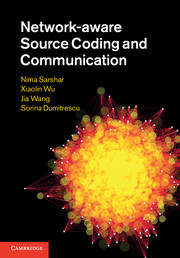1 - Introduction
Published online by Cambridge University Press: 07 October 2011
Summary
To state intuitively, the question investigated in this book is the following:
How does one communicate one or more source signals over a network from nodes (servers) that observe/supply the sources to a set of sink nodes (clients) to realize the best possible reconstruction of the signals at the clients?
The above question sets the unifying theme for the problems studied in this book, and, as will be made clear in this introduction, contains some of the most important and fundamental problems in information and network communication theory.
Network representation of source coding problems
Let's start with the observation that even the simplest source coding problems have (perhaps trivial) network representations. Figure 1.1, for instance, shows network representations of the three arguably most fundamental source coding problems. Here, the goal is to communicate a single source signal X, from a single server node s to one or more sinks. Each link of the network has a “capacity” assigned to it, which, when properly normalized, indicates the number of bits that can be communicated over that link, without errors, for every source symbol emitted from X.
Figure 1.1(a) is the simplest source coding problem. The receiver node t receives an R1 bits encoding of X from the source node s. If X admits a rate-distortion function DX(R), the reconstruction error at t is at best dt = DX(R1).
- Type
- Chapter
- Information
- Network-aware Source Coding and Communication , pp. 1 - 12Publisher: Cambridge University PressPrint publication year: 2011



